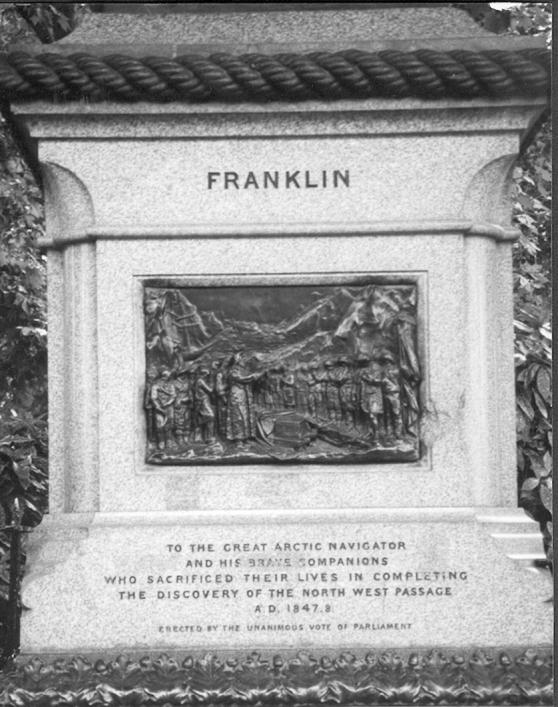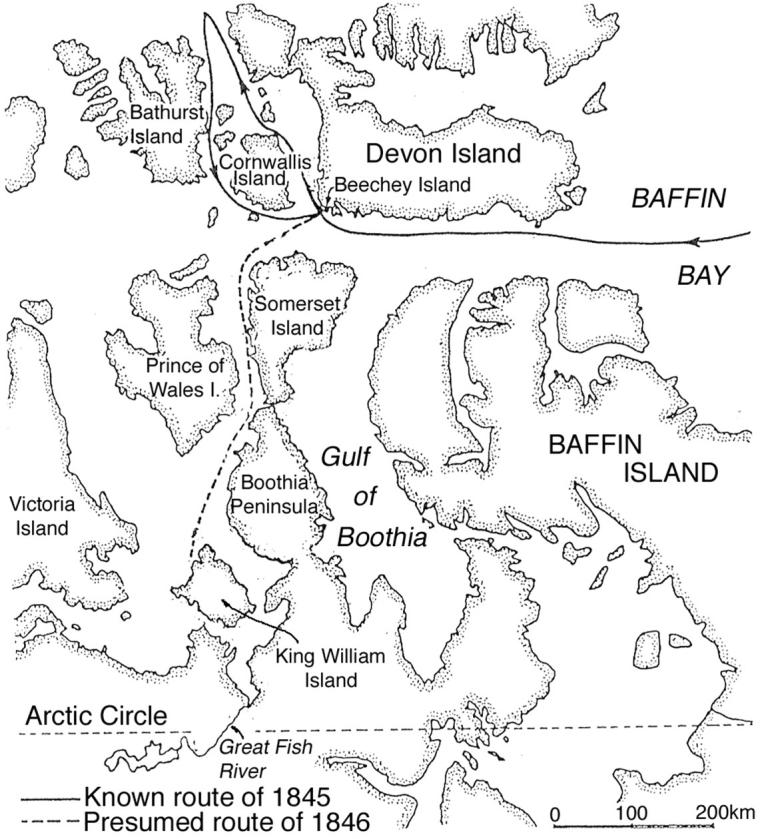Many readers of this Journal must have walked through Waterloo Place, at the southern end of Lower Regent Street in London, on their way to the Athenaeum, the Royal Society, the Royal College of Pathologists, the Academy of Medical Sciences or St James's Park. How many have stopped on the western side, a few paces to the left of the Athenaeum, to look at the 1866 statue with the unusual inscription ‘Erected by the Unanimous Vote of Parliament’ (Figure 1)? The bronze plaque depicts an arctic scene with a group of officers on the left, members of the crew on the right and a coffin in the middle. In the midnineteenth century Sir John Franklin was known nationally because of his expedition to find the middle part of the Northwest Passage, the Pacific and Atlantic entrances to which had already been discovered. Sir John was a naval officer whose experience of polar service had begun in 1818 with a failed voyage into the Spitzbergen ice to reach the North Pole. In 1819 and again in 1823 he made overland expeditions from Hudson Bay to the Polar Sea to map North America's unexplored arctic coast. On the return journey in 1823 ten men had died from hunger and cold. Franklin himself narrowly escaped death, almost succumbing to starvation before relief arrived1.
Figure 1.

The Franklin monument
On 19 May 1845 HMS Erebus, under his command, and HMS Terror, commanded by Captain Crozier, set sail from the Thames. The two ships were specially equipped for the expedition. They were centrally heated to combat the bitter winds and external temperatures of -40 °C or lower; their bows were reinforced with steel to cut through the ice; and each boat was powered by a steam engine and screw propeller, giving a speed of 3-4 knots, to aid progress when there was insufficient wind for sailing or when pack ice obstructed their course. Fuel for the engines was limited, and their power was to prove inadequate. The complement of officers and men, of whom four were cabin boys, was one hundred and twenty-nine2.
After reaching Greenland, stores from a supply ship, which then returned to England, were off-loaded on the ships. With poor prospects of obtaining food in the arctic, provisions for three years were transferred which included 8000 tins, varying in capacity from 1 to 8 lb, of pemmican, cooked beef, cooked pork, preserved meat and soup, and 930 gallons of lemon juice1. The two ships were last sighted by two whalers north of Baffin Island (Figure 2) in July 1845. Nothing was ever heard again from Franklin or his men1.
Figure 2.

Routes taken, 1845-1846
Not until the end of 1847 was concern about Franklin's disappearance expressed by the Admiralty in London. Between then and 1880 twenty-six expeditions, overland and by sea and some funded by Sir John's widow, were mounted in search of the Erebus and the Terror3. Further searches, some as recently as 1980-19982,5, have helped reveal what probably happened to Franklin's ill-fated expedition.
The appalling climatic conditions and the pack ice, which melted little in the short summer months, made navigation of the Erebus and the Terror difficult, indeed impossible. After managing to sail round Cornwallis Island, the ships wintered in 1845-1846 at Beechey Island at the south-western tip of Devon Island (Figure 2). Early in 1846 three members of the crew died and were buried there. Their graves, well prepared with head-stones, were found in August 1850 by searchers from British naval and American boats but a suggestion made by one of the ship's surgeons to carry out necropsies was rejected3.
In the winter of 1846-1847 the ships became trapped in the ice to the west of Somerset Island and the Boothia Peninsula. On 11 June 1847 Sir John Franklin, aged 61, died suddenly on board HMS Erebus4. No necropsy was done by the ship's surgeon and his grave has never been found, probably because he was buried in the ice. Now under the command of Captain Crozier the two ships were carried south by the pack ice and prevailing wind. During the winter of 1847-1848 nine officers and fifteen men fell ill and died. Within sight of King William Island and still gripped in the ice, Crozier decided on Good Friday, 22 April 1848 to abandon the ships. This decision was not precipitated by lack of food but was probably related to the poor health of his men. They had lost much weight and were weak. Some had bleeding gums and loose teeth, ecchymoses and subcutaneous haematomas, pallor and shortness of breath—features highly suggestive of scurvy. Crozier planned to continue overland to the south of King William Island and then cross to the mouth of the Great Fish River on the mainland where he hoped to get help from an outpost of the Hudson Bay Company. Dragging life-boats on sledges with them, he and his men progressed down the western coast of King William Island, travelling over the frozen ice along the coast-line because this made their passage smoother than over the rough land. Even so they managed to cover only 1½ miles or so in a day. Not a single man survived the journey although some did reach the mainland, the bodies of thirty men being subsequently found near the Great Fish River. An old Eskimo woman later told how the ill men had fallen down and died as they trudged through the ridged ice.
Expeditions in 1981-1986 by Dr Owen Beattie, an anthropologist at Alberta University, have helped explain what may have happened2. In 1981 the investigators found many skeletal remains, some of Eskimos and others from the crew of the British ships. Macroscopic examination of the bones of expedition members showed evidence of scurvy and their lead content was 228 parts per million compared with 22-36 ppm in the bones of the Eskimos. In 1984 Beattie and his team returned with the express purpose of exhuming the graves of the three members of the crew buried early in 1846. The first to be exhumed was a stoker on HMS Terror, John Torrington aged 20, who had died on 1 January 1846. The ground on top of the grave was cement-hard permafrost that had to be pickaxed to remove it. A metre down they found the coffin. Removal of the lid was difficult because it was held down with square nails and stuck to the coffin by ice. The corpse within was frozen in a block of ice. By pouring water over it, the body was thawed out and proved to be well preserved after 138 years. It was emaciated and weighed less than 40 kg with a body-mass index of 15 (normal 20-25), showing that Torrington must have lost a lot of weight since leaving England. His hands showed no evidence that he had been a stoker, and this suggested that he had been too ill to work long before he died. The lungs showed pleural adhesions, anthracosis, emphysema and evidence of tuberculosis. Death was attributed to pneumonia. Analysis of his bones showed lead levels of 110-151 ppm. The lead level in the terminal part of his scalp hair was more than 600 ppm but was slightly less in hair nearer the scalp, suggesting that his lead intake diminished during the last weeks of life when he was seriously ill.
In 1986 Beatti returned and exhumed the grave of John Harkness, a petty officer on HMS Erebus, who had died on 4 January 1846 at the age of 25. His emaciated corpse was carried to the necropsy tent, and when his clothes were cut off it was clear that a previous necropsy had been carried out, probably in 1846 on board the Erebus by Dr Goodsir, the assistant-surgeon. The corpse had a body mass index of only 14. Harkness had died of pulmonary tuberculosis. Exhumation of the grave of the Royal Marine William Baine, aged 32, who had died on 3 April 1846, followed. This corpse was also emaciated, weighing less than 40 kg. There were many superficial tooth marks which were thought to have been caused by rats that had tried to eat the body while it was still on board ship. The lungs showed evidence of tuberculosis but no organisms were cultured. Lead levels in samples of Baine's hair were 145-280 ppm. X-rays showed collapse of the eleventh thoracic vertebra due to tuberculosis (Pott's disease).
It seems that Franklin's last expedition was bedevilled by several different diseases. Tuberculosis was rampant in the nineteenth century and the conditions on Erebus and Terror would have fostered its spread among the crew. With regard to scurvy, Dr James Lind, a naval medical officer, had written his treatise on scurvy in 1754 and his 1757 paper on how to preserve the health of seamen had been adopted by the Royal Navy in 1795. Thereafter scurvy was reputed to have been eliminated. So why should it have occurred in the personnel of Franklin's last arctic exploration, despite each man allegedly receiving one ounce of lemon juice daily? Ascorbic acid is an unstable substance and prolonged storage, with or without refrigeration, may impair its function. It is possible that the lemon juice began to ferment and was boiled to prevent this—a procedure that would have destroyed the ascorbic acid.
The chemical evidence of lead poisoning is almost certainly due to the soldering of the cans that contained the preserved meats. The technology for preparing canned meat was new, having been patented in 1811, and the cans were sealed with a solder of tin and a high lead content. Contaminating the meat immediately adjacent, this solder was the probable cause of the high lead levels found in the bones and hair of the crew. This would have led to anorexia, fatigue and weakness from peripheral neuritis, intestinal colic and psychological manifestations such as anxiety and paranoia. Another suggestion (Martin S, personal communication) is that the poor quality of the canning could have led to botulism.
References
- 1.Cyriax RJ. Sir John Franklin's Last Arctic Expedition. London: Methuen, 1939
- 2.Beattie O, Geiger J. Frozen in Time. London: Bloomsbury, 1987
- 3.Savour A. The Search for the North West Passage. London: Chatham, 1999
- 4.McGregor E. The Ice Girl. London: Bantam Press, 2001
- 5.The Franklin Trail. [www.netscades.com/franklintrail ]


